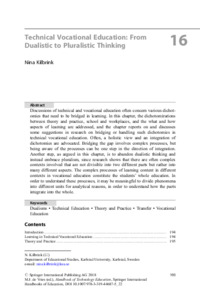Technical Vocational Education: From Dualistic to Pluralistic ThinkingNina Kilbrink
|
 |
 Diese Seite wurde seit 2 Jahren inhaltlich nicht mehr aktualisiert.
Unter Umständen ist sie nicht mehr aktuell.
Diese Seite wurde seit 2 Jahren inhaltlich nicht mehr aktualisiert.
Unter Umständen ist sie nicht mehr aktuell.
 Zusammenfassungen
Zusammenfassungen
 Discussions of technical and vocational education often concern various dichotomies that need to be bridged in learning. In this chapter, the dichotomizations between theory and practice, school and workplaces, and the what and how aspects of learning are addressed, and the chapter reports on and discusses some suggestions in research on bridging or handling such dichotomies in technical vocational education. Often, a holistic view and an integration of dichotomies are advocated. Bridging the gap involves complex processes, but being aware of the processes can be one step in the direction of integration. Another step, as argued in this chapter, is to abandon dualistic thinking and instead embrace pluralism, since research shows that there are often complex contexts involved that are not divisible into two different parts but rather into many different aspects. The complex processes of learning content in different contexts in vocational education constitute the students´ whole education. In order to understand these processes, it may be meaningful to divide phenomena into different units for analytical reasons, in order to understand how the parts integrate into the whole.
Discussions of technical and vocational education often concern various dichotomies that need to be bridged in learning. In this chapter, the dichotomizations between theory and practice, school and workplaces, and the what and how aspects of learning are addressed, and the chapter reports on and discusses some suggestions in research on bridging or handling such dichotomies in technical vocational education. Often, a holistic view and an integration of dichotomies are advocated. Bridging the gap involves complex processes, but being aware of the processes can be one step in the direction of integration. Another step, as argued in this chapter, is to abandon dualistic thinking and instead embrace pluralism, since research shows that there are often complex contexts involved that are not divisible into two different parts but rather into many different aspects. The complex processes of learning content in different contexts in vocational education constitute the students´ whole education. In order to understand these processes, it may be meaningful to divide phenomena into different units for analytical reasons, in order to understand how the parts integrate into the whole. Dieses Kapitel erwähnt ...
Dieses Kapitel erwähnt ...
 Personen KB IB clear | Hubert L. Dreyfus , S. Dreyfus | ||||||||||||||||||
 Bücher |
|
 Zitationsgraph (Beta-Test mit vis.js)
Zitationsgraph (Beta-Test mit vis.js)
 Anderswo finden
Anderswo finden
 Volltext dieses Dokuments
Volltext dieses Dokuments
 |  Technical Vocational Education: From Dualistic to Pluralistic Thinking: Artikel als Volltext bei Springerlink ( Technical Vocational Education: From Dualistic to Pluralistic Thinking: Artikel als Volltext bei Springerlink ( : :  , 183 kByte; , 183 kByte;  : :  ) ) |
 Anderswo suchen
Anderswo suchen 
 Beat und dieses Kapitel
Beat und dieses Kapitel
Beat hat Dieses Kapitel während seiner Zeit am Institut für Medien und Schule (IMS) ins Biblionetz aufgenommen. Beat besitzt kein physisches, aber ein digitales Exemplar. Eine digitale Version ist auf dem Internet verfügbar (s.o.). Aufgrund der wenigen Einträge im Biblionetz scheint er es nicht wirklich gelesen zu haben. Es gibt bisher auch nur wenige Objekte im Biblionetz, die dieses Werk zitieren.











 Biblionetz-History
Biblionetz-History